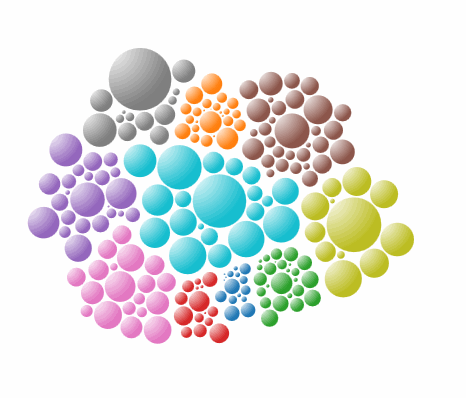Draw a D3 circle with gradient colours
How to draw a circle with gradient color? Say, a gradient from yellow to blue.
Normally, to create a circle in yellow we can use the following code:
var
-
You have to define the gradient in the SVG first, and then fill the circle with an SVG link to the gradient element.
// Define the gradient var gradient = svg.append("svg:defs") .append("svg:linearGradient") .attr("id", "gradient") .attr("x1", "0%") .attr("y1", "0%") .attr("x2", "100%") .attr("y2", "100%") .attr("spreadMethod", "pad"); // Define the gradient colors gradient.append("svg:stop") .attr("offset", "0%") .attr("stop-color", "#a00000") .attr("stop-opacity", 1); gradient.append("svg:stop") .attr("offset", "100%") .attr("stop-color", "#aaaa00") .attr("stop-opacity", 1); // Fill the circle with the gradient var circle = svg.append('circle') .attr('cx', width / 2) .attr('cy', height / 2) .attr('r', height / 3) .attr('fill', 'url(#gradient)');A jsFiddle with the complete example. More details on how to define SVG gradients in the MDN Tutorial. The resulting image:
 讨论(0)
讨论(0) -
Take a look at this code snippet:
var width = 500, height = 500, padding = 1.5, // separation between same-color nodes clusterPadding = 6, // separation between different-color nodes maxRadius = 12; var n = 200, // total number of nodes m = 10; // number of distinct clusters var color = d3.scale.category10() .domain(d3.range(m)); // The largest node for each cluster. var clusters = new Array(m); var nodes = d3.range(n).map(function() { var i = Math.floor(Math.random() * m), r = Math.sqrt((i + 1) / m * -Math.log(Math.random())) * maxRadius, d = {cluster: i, radius: r}; if (!clusters[i] || (r > clusters[i].radius)) clusters[i] = d; return d; }); // Use the pack layout to initialize node positions. d3.layout.pack() .sort(null) .size([width, height]) .children(function(d) { return d.values; }) .value(function(d) { return d.radius * d.radius; }) .nodes({values: d3.nest() .key(function(d) { return d.cluster; }) .entries(nodes) }); var force = d3.layout.force() .nodes(nodes) .size([width, height]) .gravity(.02) .charge(0) .on("tick", tick) .start(); var svg = d3.select("body").append("svg") .attr("width", width) .attr("height", height); var grads = svg.append("defs").selectAll("radialGradient") .data(nodes) .enter() .append("radialGradient") .attr("gradientUnits", "objectBoundingBox") .attr("cx", 0) .attr("cy", 0) .attr("r", "100%") .attr("id", function(d, i) { return "grad" + i; }); grads.append("stop") .attr("offset", "0%") .style("stop-color", "white"); grads.append("stop") .attr("offset", "100%") .style("stop-color", function(d) { return color(d.cluster); }); var node = svg.selectAll("circle") .data(nodes) .enter() .append("circle") .style("fill", function(d, i) { return "url(#grad" + i + ")"; }) // .style("fill", function(d) { return color(d.cluster); }) .call(force.drag); node.transition() .duration(750) .delay(function(d, i) { return i * 5; }) .attrTween("r", function(d) { var i = d3.interpolate(0, d.radius); return function(t) { return d.radius = i(t); }; }); function tick(e) { node .each(cluster(10 * e.alpha * e.alpha)) .each(collide(.5)) .attr("cx", function(d) { return d.x; }) .attr("cy", function(d) { return d.y; }); } // Move d to be adjacent to the cluster node. function cluster(alpha) { return function(d) { var cluster = clusters[d.cluster]; if (cluster === d) return; var x = d.x - cluster.x, y = d.y - cluster.y, l = Math.sqrt(x * x + y * y), r = d.radius + cluster.radius; if (l != r) { l = (l - r) / l * alpha; d.x -= x *= l; d.y -= y *= l; cluster.x += x; cluster.y += y; } }; } // Resolves collisions between d and all other circles. function collide(alpha) { var quadtree = d3.geom.quadtree(nodes); return function(d) { var r = d.radius + maxRadius + Math.max(padding, clusterPadding), nx1 = d.x - r, nx2 = d.x + r, ny1 = d.y - r, ny2 = d.y + r; quadtree.visit(function(quad, x1, y1, x2, y2) { if (quad.point && (quad.point !== d)) { var x = d.x - quad.point.x, y = d.y - quad.point.y, l = Math.sqrt(x * x + y * y), r = d.radius + quad.point.radius + (d.cluster === quad.point.cluster ? padding : clusterPadding); if (l < r) { l = (l - r) / l * alpha; d.x -= x *= l; d.y -= y *= l; quad.point.x += x; quad.point.y += y; } } return x1 > nx2 || x2 < nx1 || y1 > ny2 || y2 < ny1; }); }; }<script src="https://cdnjs.cloudflare.com/ajax/libs/d3/3.4.11/d3.min.js"></script>It contains support for drawing SVG circles with gradient (and achieving a 3D look-and-feel effect by doing this) and is based on SVG radial gradients.
For each node, a gradient is defined:
var grads = svg.append("defs").selectAll("radialGradient") .data(nodes) .enter() .append("radialGradient") .attr("gradientUnits", "objectBoundingBox") .attr("cx", 0) .attr("cy", 0) .attr("r", "100%") .attr("id", function(d, i) { return "grad" + i; }); grads.append("stop") .attr("offset", "0%") .style("stop-color", "white"); grads.append("stop") .attr("offset", "100%") .style("stop-color", function(d) { return color(d.cluster); });Then, instead of line:
.style("fill", function(d) { return color(d.cluster); })this line is added in the code that creates circles:
.attr("fill", function(d, i) { return "url(#grad" + i + ")"; })This produces this effect:(animated gif that I used has some limitations for number of colors, so gradients are not smooth as in real example)
 讨论(0)
讨论(0)
- 热议问题

 加载中...
加载中...